Wingspan 21 m Length 21 m | Weight 9,100 kg Introduced 1993 | |
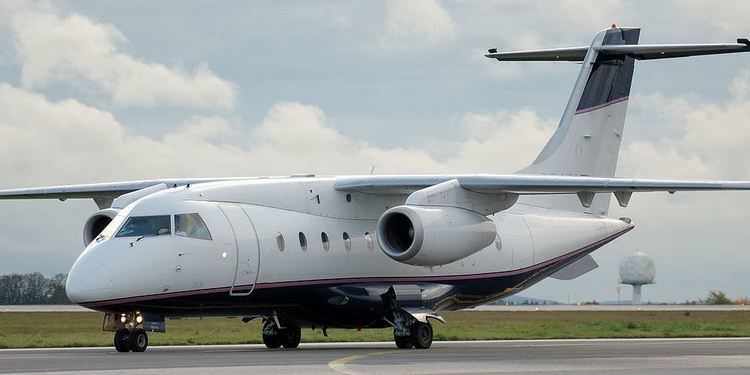 | ||
Unit cost 7,000,000–8,000,000 USD (2013) Manufacturers Fairchild Aircraft, Dornier Flugzeugwerke | ||
Close takeoff of a dornier 328 with nice turboprop sound hd
The Dornier 328 is a turboprop-powered commuter airliner. Initially produced by Dornier Luftfahrt GmbH, the firm was acquired in 1996 by Fairchild Aircraft. The resulting firm, named Fairchild-Dornier, manufactured the 328 family in Oberpfaffenhofen, Germany, conducted sales from San Antonio, Texas, United States, and supported the product line from both locations. There is also a jet-powered version of the aircraft, the Fairchild Dornier 328JET.
Contents
- Close takeoff of a dornier 328 with nice turboprop sound hd
- Skywork airlines dornier 328 turboprop take off at the airport bern belp
- Origins
- Further development
- Design
- Operational history
- Variants
- Operators
- MilitaryGovernment
- Civilian
- Accidents
- Specifications Dornier 328 110
- References
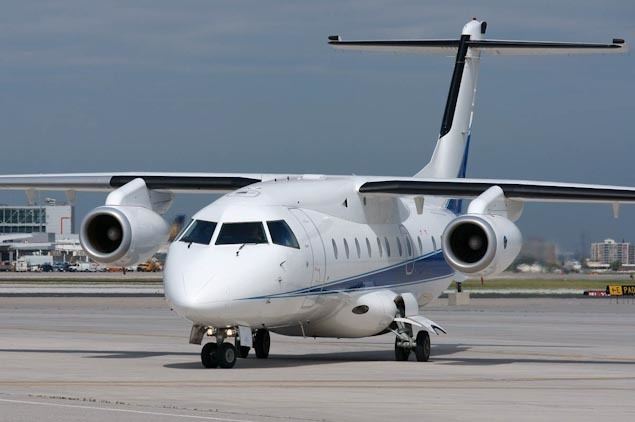
Skywork airlines dornier 328 turboprop take off at the airport bern belp
Origins
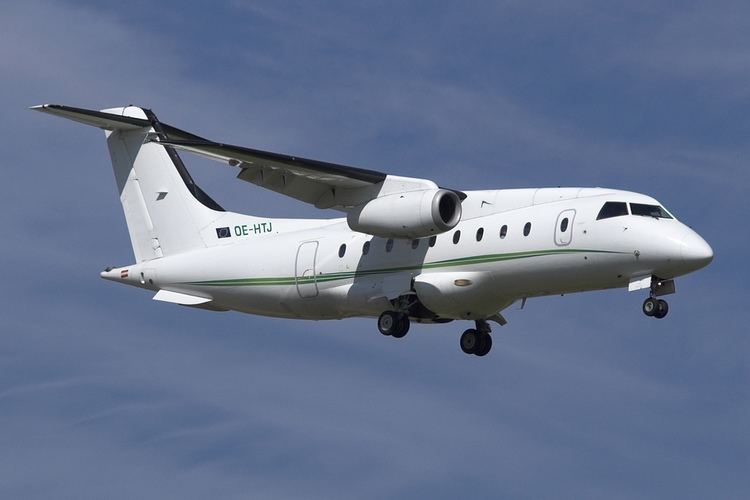
The Dornier 328 (or Do 328) program was initially started while Dornier was still owned by Deutsche Aerospace. According to Deutsche Aerospace program manager Reinhold Birrenbach, the 328 had its origins in market research conducted in and around 1984; feedback from airlines indicated a desire for a fast, quiet and easy to maintain commuter airliner with a 30-seat capacity. This market research reportedly led Deutsche Aerospace to formulate a sales prediction of 400 or greater units being purchased overall; this forecast was in part derived from the reasoning that the 328 would be more advanced than its nearest competitors. Favourable features included a high cruising speed of 345 kt (640 km/h) as well as a higher cruising altitude and range, making the aircraft almost as fast as jet airliners while being more fuel-efficient; a trend away from spoke–and-hub distribution in favour of point-to-point transit was also viewed as being favourable to the 328.
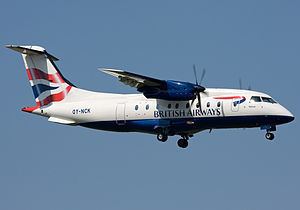
In December 1988, the 328 project was re-launched following the granting of shareholder approval after negotiations between the Dornier family and Daimler Benz. As the result of a six-month evaluation, a selection of powerplants deemed to be appropriate for the 328 was formed, these being the General Electric CT7-9D, the Garrett TPE-341-21 and the Pratt & Whitney Canada PW119A. While the Garrett engine was viewed by Deutsche Aerospace as being technically superior, Pratt & Whitney's powerplant was more advanced in development and thus was chosen. The engine selection was soon followed by the selection of a six-bladed composite propeller from Hartzell, Hartzell's submission being reportedly substantially lighter than competing bids from Dowty and Hamilton Standard. Following various considerations between electromechanical and digital instrumentation, Dornier opted for a digital glass cockpit and selected Honeywell to provide this after considering options from Saab Group, Rockwell Collins, and Smiths Aerospace.
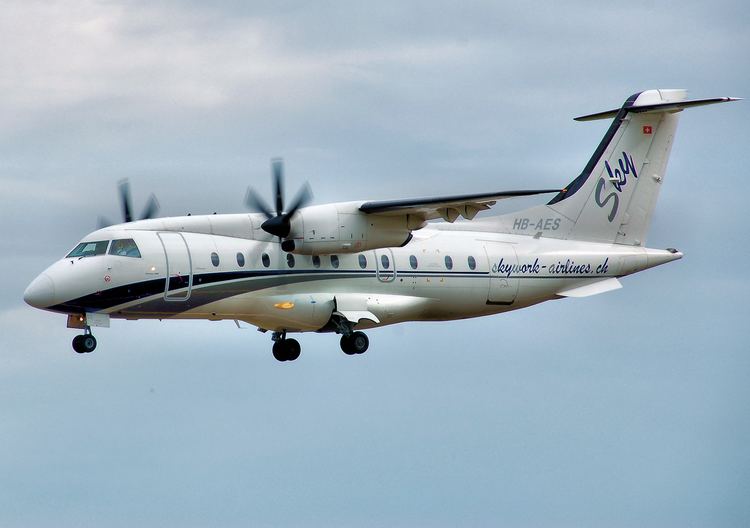
In May 1991, Horizon Air, a US-based airline, placed an order for 35 aircraft, this was the largest order for the 328 at that point and was larger than any other order for it or its competitors to be placed that year. In October 1991, the first prototype of the 328 was formally rolled out. On 6 December 1991, the first prototype conducted the type's maiden flight. On 4 June 1992, a second 328 prototype performed its first flight. On 14 December 1992, one of the 328 prototypes suffered a near-catastrophic in-flight propeller failure when all six propeller blades on one engine detached before puncturing the fuselage, the subsequent temporary loss of control caused the aircraft to roll 280 degrees and descent 5,000 feet before control was recovered.
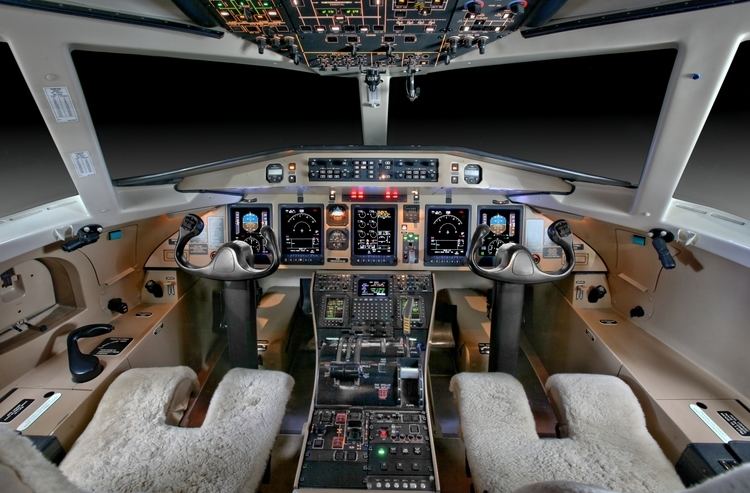
On 13 October 1993, the 328 formally entered commercial service. The 328 was launched onto the market during a period in which it was crowded with large numbers of competing turboprop aircraft, as well as facing increasing competition from newly launched regional jets, which were becoming increasingly popular during the early 1990s. The 328 had the advantages of being both quieter and faster than many of its rivals, however this did not ensure its commercial success. The latter half of the 328 program was performed during a recession, curtailing demand for new aircraft from operators. Both the 328 and the wider Dornier division of Deutsche Aerospace both proved to be losing money; accordingly Deutsche Aerospace wavered in committing more resources to the regional aircraft market, repeatedly delaying a decision to proceed with a 48-seat stretched model of the 328, which had originally been unveiled in 1991.
Further development
During the early 1990s, Deutsche Aerospace and Fokker explored the prospects of a commercial relationship to mutually engage the regional aircraft market; this cumulated in Deutsche Aerospace purchasing a 40 per cent stake in Fokker in 1993. In June 1995, Deutsche Aerospace and Daewoo Heavy Industries were reportedly conducting talks on the establishment of a second 328 assembly line in South Korea for the Asian market. In 1995, both Fokker and Deutsche Aerospace suffered substantial financial difficulties, which ultimately led to the abortion of the latter's ambitions to dominate the European regional aircraft market. In June 1996, Deutsche Aerospace sold the majority of Dornier Luftfahrt GmbH to American manufacturer Fairchild Aircraft, leading to the creation of Fairchild Dornier GmbH. The newly combined Fairchild Dornier company emerged as the third largest regional aircraft manufacturer in the world, and viewed the 328 as being both a key product in its lineup and the basis for a future family of aircraft.
In addition to continuing development of a jet-powered variant of the 328, initially designated as the Dornier 328-300 and later simply known as the Dornier 328JET, which had been started under Deutsche Aerospace; Fairchild Dornier sought to develop a stretched version, designated as the Dornier 428JET, and a dedicated freighter model. Further derivatives of the 328 included the shortened Dornier 528, the further stretched Dornier 728JET and the significantly enlargened Dornier 928JET. In addition to typical passenger models, business jet configurations of both the 728JET and 928JET were projected, tentatively referred to as Envoy 3 and Envoy 7 respectively. The ambitious family project drew the support of the German government, who guaranteed $350 million-worth of loans for the scheme. During the late 1990s, Fairchild Dornier struggled to find both capital and strategic partners to support the project, and the company ultimately entered bankruptcy in April 2002.
Following the bankruptcy of Fairchild Dornier, the rights to the Dornier 328 and its 328JET cousin were acquired by AvCraft Aviation, however this company entered bankruptcy itself less than three years later. In June 2006, 328 Support Services GmbH acquired the type certificate for the Dornier 328 but did not pursue production of the type, instead electing to focus on providing maintenance, repair, and overhaul services to the existing in-service fleet. In February 2015, 328 Support Services GmbH was itself acquired by the US engineering company Sierra Nevada Corporation. Shortly thereafter, Seirra Nevada's owner, Turkish-American Engineer Fatih Ozmen, established a private corporation named Özjet Havacılık Teknolojileri A.Ş. at Technopark of Bilkent University, Ankara and signed a Memorandum of understanding with the Turkish Ministry of Transport, Maritime Affairs & Communications in order to manufacture the 328 at Ankara.
In June 2015, the Turkish government announced the formal launch of the Turkish regional aircraft project, which intends to manufacture a modernized version of Dornier 328/Fairchild Dornier 328JET, designated as the TRJ-328. At the time, multiple powerplants were being considered for the aircraft with the use of either a turboprop or jet engine being possible. The TRJ-328 shall also serve as the technology base for a larger TRJ-628 which is intended to be designed, developed and produced entirely by Turkish engineers. Turkish Aerospace Industries (TAI) has been placed in charge of manufacturing activities, alongside several other Turkish companies, including ASELSAN, TEI, HAVELSAN, Turkish Technic, Alp Aviation and Kale Aviation. Initially, parts of the original supply chain shall be used, but these are to be replaced by Turkish-sourced counterparts once available.
Design
The Dornier 328 is a twin-turboprop engine regional aircraft, principally designed for shorthaul passenger operators; Deutsche Aerospace often promoted the type as being a "third-generation airliner". The fuselage of the 328 employs an unusual steamlined shape, having been optimised for high cruising speeds; the aircraft is capable of higher cruise and approach speeds than most turboprop-powered aircraft, this allows it to be more readily slotted around jetliners during landing approaches. According to Deutsche Aerospace, the 328 offered the "lowest noise level, widest cabin, highest standing room, widest cabin floor, and widest seats in the three-abreast class". The 328 is capable of operations from semi-prepared airstrips and rough runways, incorporating features such as its retractable landing gear being equipped with high-floatation tyres and steerable nose gear and a gravel guard.
It is equipped with a pair of Pratt and Whitney PW119C turboprop engines, which drive fully reversible Hartzell HD-E6C-3B propellers. The propeller blades generate notably less noise in comparison to their contemporary counterparts due to features such as their lower RPM, propeller synchrophasing, and the use of a six-blade configuration. The propeller system is dual-acting, being capable of adjusting pitch to maintain a constant engine RPM. During the early 1990s, the manufacturer claimed that the use of various noise reduction measures across the aircraft kept the internal cabin noise "below that of even some modern jet aircraft".
The fuselage of 328 allows for a comfortable three-abreast airline-style seating arrangement to be used as well as a dense four-abreast configuration to accommodate greater passenger numbers, of which it is able to carry a maximum of 27. There are a total of six cabin configurations available for passenger and cargo operations, these include a flexible combi aircraft layout with a movable wall separating passengers and cargo, and a medical evacuation arrangement equipped with bio-floors and positions for four litters and medical attendees. The 328 is pressurized, a first for Dornier-built aircraft, which was implemented to achieve a higher level of passenger comfort; the passenger cabin is designed to be more akin to those of much larger passenger aircraft. A full-sized galley, toilet and washbasin can also be installed.
The 328 is furnished with the same supercritical wing design that had been originally developed from Dornier's earlier Do 228, this wing provides the aircraft with both excellent cruise and climb capabilities. The straightforward construction techniques of the Do 228 were also reproduced for the 328, despite making increased use of composite materials in areas such as the rear fuselage and empennage. The 328 reportedly made greater use of composites than any of its direct competitors at launch, the use of the Kevlar-carbon fiber composites is claimed to have reduced its weight by 20 per cent. Various materials are used across the airframe; amongst these, an aluminium alloy is used for the pressure fuselage and much of the wingbox, a titanium alloy for the tail cone, and glass fibre reinforced plastic for the radome and leading edge of the vertical stabilizer. Noise-absorbent material is located across the fuselage, while the cabin wall is hung from isolator brackets to reduce vibration and noise transference.
The two-man glass cockpit of the 328 is equipped with a Honeywell Primus 2000 avionics suite, the cockpit is outfitted with an electronic flight instrument system comprising five 20 x 17.5 cm cathode ray tube (CRT) monitors. The central CRT serves as the engine-indicating and crew-alerting system, while the two inner CRTs are used as multi-function displays and the outermost two CRTs perform as the primary flight displays respectively. Addition avionics include a dual integrated avionics computer, a digital databus (a commercial derivative of the MIL-STD-1553 databus), dual Primus II integrated radio system, automatic flight control system, dual digital air data reference units, Primus 650 weather radar, dual mode-S transponder, enhanced ground proximity warning system, and traffic collision avoidance system (TCAS).
Operational history
In 2005, the Australian Maritime Safety Authority (AMSA) awarded a contract to AeroRescue to provide long-range Search and Rescue (SAR) capability around Australia. Accordingly, five 328-100s were progressively commissioned from April 2006 to February 2007 and stationed around the Australian coastline to provide a 24-hour, 30 minute response capability. These aircraft were equipped with a comprehensive electronic sensor suite by Aerodata AG in Germany including; Israel Aerospace Industries ELTA EL/M 2022A Radar, FSI Star SAFire III Forward Looking Infra Red (FLIR), Direction Finder and an ARGON ST Infra Red/Ultra Violet scanner. The aircraft are also fitted with an Aeronautical Engineers Australia dispatch system, allowing rescue stores to be dropped from the aircraft through a chute through the underwing emergency exit. These are progressively being upgraded with an inflight opening cargo door to allow dispatch of larger items, up to 20-man life rafts and boat dewatering pumps for open water rescues.
Variants
Operators
In August 2013 a total of 166 remain in operation with 48 Dornier 328-100 aircraft in airline service. Major operators include: Loganair (5), and Sky Work Airlines (5). Thirteen other airlines operate smaller numbers of the type.
Military/Government
Civilian
The Dornier 328 turboprop was also operated in the past in scheduled passenger service by several U.S. regional airlines including Air Wisconsin, Horizon Air, Lone Star Airlines, and Mountain Air Express. In addition, the aircraft was previously used to provide passenger feeder services in the U.S. operating as United Express and US Airways Express flights.
Accidents
Specifications (Dornier 328-110)
General characteristics
Performance
Avionics
Honeywell Primus 2000
